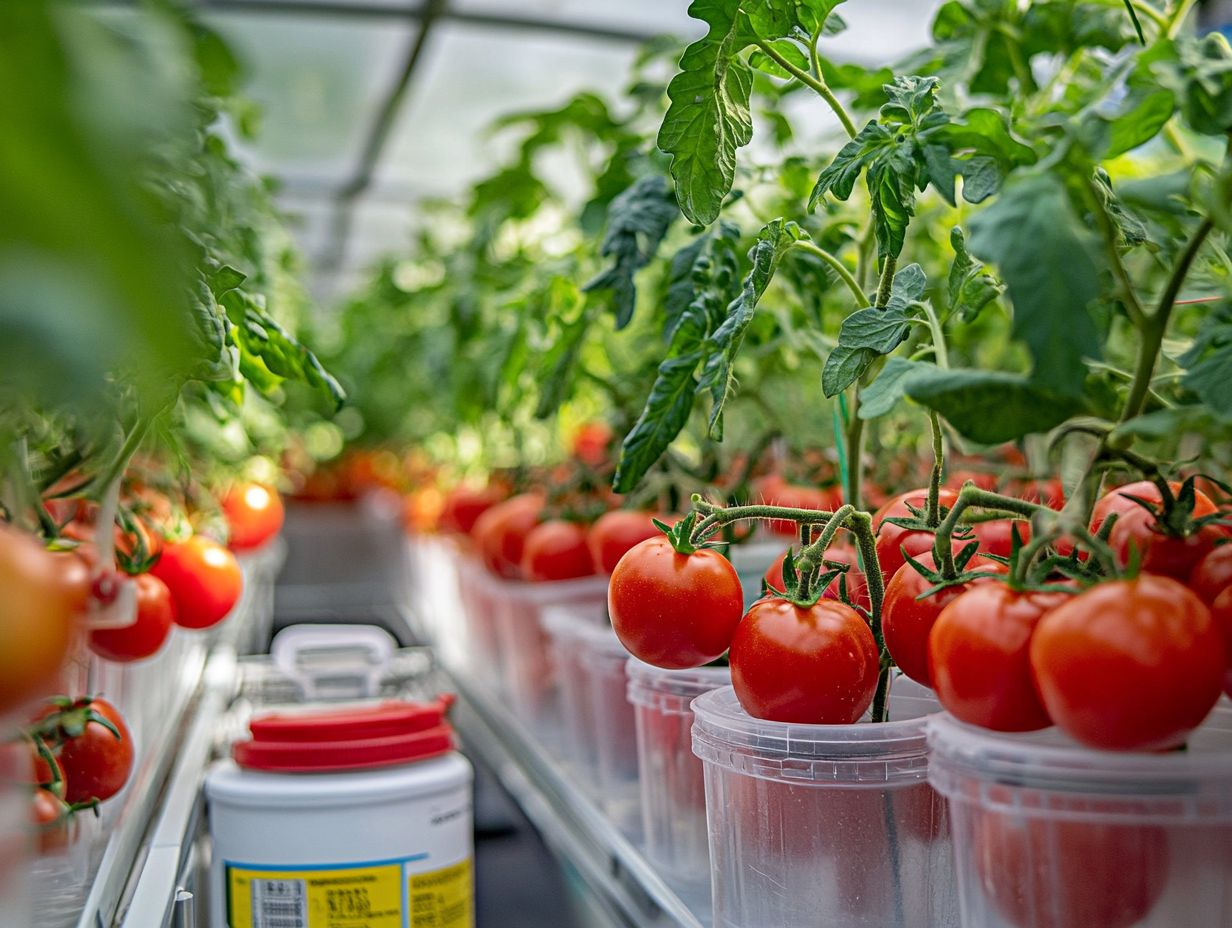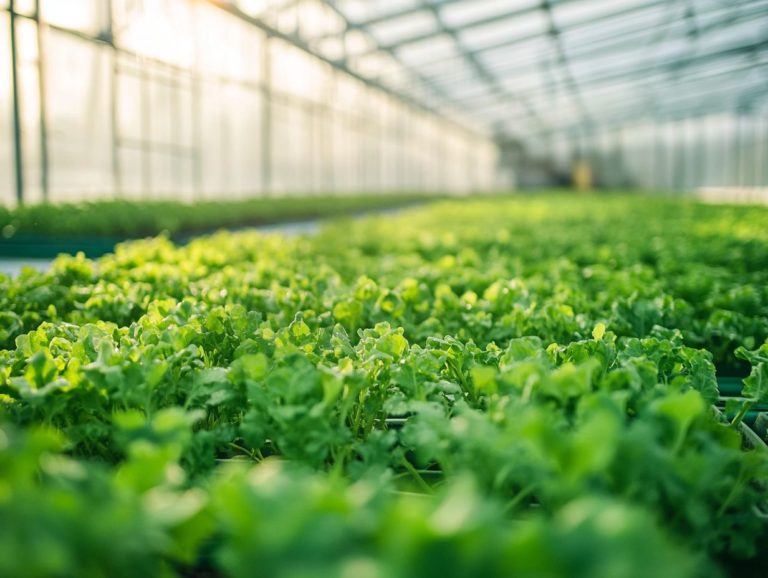Hydroponic Nutrient Solutions for Tomatoes
Growing tomatoes hydroponically can be an incredibly rewarding endeavor. Your success largely rests on selecting the right nutrient solutions.
These specialized blends are crafted to support optimal growth, boost yields, and reduce the risk of diseases and pests. This article delves into the benefits of hydroponic nutrient solutions specifically tailored for tomatoes, compares organic and synthetic options, and provides guidance on how to choose and prepare the ideal mix for your plants. It also addresses common challenges you may face along the journey.
Get ready to take your hydroponic gardening to the next level!
Contents
- Key Takeaways:
- Unlock Incredible Benefits of Hydroponic Nutrients for Your Tomatoes!
- Types of Hydroponic Nutrient Solutions
- Choosing the Right Nutrient Solution for Tomatoes
- How to Prepare and Use Hydroponic Nutrient Solutions
- Troubleshooting Common Issues with Nutrient Solutions
- Frequently Asked Questions
- What are hydroponic nutrient solutions for tomatoes?
- What nutrients are needed for hydroponic tomatoes?
- How often should I change the nutrient solution for hydroponic tomatoes?
- Can I make my own hydroponic nutrient solution for tomatoes?
- What are the benefits of using hydroponic nutrient solutions for tomatoes?
- Are there different types of nutrient solutions for tomatoes?
Key Takeaways:

- Hydroponic nutrient solutions can help tomatoes grow faster and produce higher yields compared to traditional soil methods.
- These solutions also reduce the risk of diseases and pests, leading to healthier plants.
- When choosing a nutrient solution for tomatoes, consider factors such as plant stage, water quality, and nutrient levels to ensure optimal growth.
What are Hydroponic Nutrient Solutions?
Hydroponic nutrient solutions are specially mixed liquids that provide essential nutrients to your plants in systems like greenhouses. These solutions are vital for supplying important nutrients needed in large amounts (macronutrients) like nitrogen, potassium, and calcium, along with important nutrients needed in small amounts (micronutrients) such as iron and zinc.
Each nutrient is crucial for optimal growth throughout the plant’s life cycle, from germination to fruit development. Take tomato cultivation, for example. You need to tailor nutrient concentrations precisely to meet the plant’s demands at each growth stage, fostering robust root development and bountiful fruit yields. Exploring organic nutrient options for hydroponic systems can further enhance your gardening success.
Adjusting nutrient ratios ensures your tomatoes receive the perfect blend for maximum health and productivity. Don’t overlook pH levels; they are critical for maintaining nutrient solubility and availability.
Regularly analyzing nutrients allows you to monitor the effectiveness of your solutions, ensuring that your plants efficiently absorb essential elements. This vigilance safeguards their overall vitality and enhances their yield potential.
Unlock Incredible Benefits of Hydroponic Nutrients for Your Tomatoes!
Utilizing hydroponic nutrient solutions for tomato cultivation presents a wealth of benefits, greatly enhancing both plant health and yield. These solutions are designed to meet the precise nutrient requirements of tomatoes, ensuring optimal growth by delivering a well-balanced supply of essential nutrients.
This approach not only promotes disease resistance but also boosts productivity in controlled environments, such as hydroponic greenhouses and through methods like Nutrient Film Technique.
Improved Growth and Yield
One of the key benefits of using hydroponic nutrient solutions is the remarkable improvement in both the growth and yield of your tomato crops. This is vital whether you re involved in commercial farming or simply nurturing a home garden.
This method gives you the power to fine-tune the nutrient balance, creating the perfect environment for your tomatoes to flourish. Essential macronutrients like nitrogen, phosphorus, and potassium play pivotal roles at different growth stages, and using nutrient solutions in different growing systems can enhance their effectiveness.
For example, nitrogen is critical during the vegetative stage, fostering lush, leafy growth, while phosphorus aids in robust root development and flowering. Potassium, on the other hand, enhances the quality and size of your fruits as they mature.
By carefully managing these nutrient concentrations, you can significantly accelerate growth rates and attain higher yields. This ensures that your harvests are not just plentiful but also meet the demands of the market.
Start experimenting with your nutrient ratios today for healthier, more productive tomatoes!
Reduced Risk of Disease and Pests
By utilizing hydroponic nutrient solutions, you can dramatically reduce the risk of diseases and pests that frequently plague tomato crops. This ensures your plants thrive and your harvest remains dependable.
This method grants you precise control over the essential nutrients your plants absorb, directly impacting their health and resilience. For those specifically growing peppers, using the best hydroponic nutrient solutions fosters vigorous growth and fortifies the plant’s immune system, enabling it to effectively combat potential pathogens.
Regular nutrient analysis helps you identify deficiencies or excesses in real-time. This allows you to make timely adjustments and prevent imbalances. Adopting these preventative strategies reduces the need for chemical treatments and supports sustainable practices, leading to stronger, more resilient tomato varieties.
Types of Hydroponic Nutrient Solutions

There are two primary types of hydroponic nutrient solutions: organic and synthetic. Each comes with unique advantages and is better suited to different hydroponic systems.
Organic vs. Synthetic Solutions
Organic solutions harness naturally derived nutrients, while synthetic options are chemically formulated. Each influences nutrient uptake and plant growth in distinct ways.
Organic choices not only enhance soil health over time but also offer a gradual release of nutrients. This fosters sustained growth with a reduced risk of nutrient burn. In contrast, synthetic solutions provide immediate nutrient availability, which can be tempting for quick results in urgent situations.
However, synthetic options often raise concerns about their long-term impacts on soil ecosystems and water quality. Ultimately, the decision between organic and synthetic solutions rests on your specific growing conditions and desired outcomes, reflecting your commitment to environmental stewardship.
Choosing the Right Nutrient Solution for Tomatoes
Selecting the right nutrient solution for your tomatoes is essential for optimal growth and yield. It requires careful consideration of several important factors.
Factors to Consider
Several critical factors influence your choice, such as water quality, pH control, electrical conductivity, and nutrient analysis. Understanding these variables is vital for ensuring optimal growth in hydroponic systems.
Water quality plays a crucial role; contaminants can hinder nutrient absorption and negatively affect plant vigor. Keeping a close eye on pH levels is equally important. Maintaining an ideal range of 5.5 to 6.5 promotes nutrient availability and prevents deficiencies or toxicities. For more in-depth information, check out understanding hydroponic nutrient solutions.
Electrical conductivity measures how well nutrients dissolve in water, providing insights into nutrient concentration. You can fine-tune your feeding schedules effectively through regular analysis.
By sourcing reliable water, frequently calibrating pH meters, and meticulously recording nutrient levels, you ll enhance the health and productivity of your tomato crops.
How to Prepare and Use Hydroponic Nutrient Solutions
When preparing and utilizing hydroponic nutrient solutions, adopt a systematic approach to ensure your nutrient mix is effective and tailored to your tomato crop. This attention to detail is crucial for nurturing healthy and productive plants.
Step-by-Step Instructions

To prepare hydroponic nutrient solutions for your tomato crop, follow these meticulously crafted instructions to ensure precise mixing and application.
Start by gathering all the essential ingredients, including macro and micronutrients such as nitrogen, phosphorus, potassium, calcium, magnesium, and trace elements. For more detailed guidance, explore the top hydroponic systems and their nutrient needs. Accuracy is key, so use a digital scale or measuring spoons to measure each ingredient correctly. The health and yield of your plants depend on it.
Once you have your ingredients ready, mix them in clean, distilled water until you achieve a uniform solution. Monitor the nutrient levels, as they can change depending on the growth stage of your tomatoes. For instance, seedlings need lower levels, while fruiting plants thrive on a richer blend. To get the most out of your setup, consider understanding hydroponic nutrient solutions for optimal growth.
Regularly calibrate your nutrient solution using a pH meter and an EC (electrical conductivity) meter. This helps ensure that it meets the specific nutritional needs of your plants at every growth stage.
Troubleshooting Common Issues with Nutrient Solutions
Troubleshooting common issues with hydroponic nutrient solutions is crucial for maintaining healthy tomato crops and achieving the growth outcomes you desire.
Identifying and Addressing Problems
Identifying and addressing issues in hydroponic nutrient solutions like nutrient deficiencies or pH imbalances is essential for the health and productivity of your tomato crops.
If you don’t act promptly, these problems can show clear signs, such as leaf discoloration, which ranges from yellowing to browning. This may signal a deficiency in essential nutrients. You might also notice stunted growth as your plants struggle in less-than-ideal conditions. Observing these symptoms is crucial; they serve as early indicators of potential nutrient imbalances that you can’t afford to ignore.
Conduct a nutrient analysis to tackle these problems effectively. This helps you adjust the nutrient solution for better plant growth, promoting robust plant development and maximizing your overall crop yield.
Frequently Asked Questions
What are hydroponic nutrient solutions for tomatoes?
Hydroponic nutrient solutions for tomatoes are specially formulated mixtures of essential nutrients dissolved in water, used to feed tomato plants grown in a hydroponic system.
What nutrients are needed for hydroponic tomatoes?

Hydroponic tomatoes require a balance of macronutrients (like nitrogen, phosphorus, and potassium) and micronutrients (such as calcium, magnesium, and iron) for healthy growth and development.
How often should I change the nutrient solution for hydroponic tomatoes?
Change your nutrient solution every 1-2 weeks for healthy, thriving tomatoes! Also, do so when the solution becomes discolored or begins to smell, while regularly monitoring the electrical conductivity for proper nutrient balance.
Can I make my own hydroponic nutrient solution for tomatoes?
Yes, you can make your own hydroponic nutrient solution for tomatoes using various fertilizers and supplements, such as soluble fertilizers. However, research and follow proper nutrient ratios to avoid overloading or underfeeding the plants, especially during the transplanting process.
What are the benefits of using hydroponic nutrient solutions for tomatoes?
Hydroponic nutrient solutions for tomatoes offer several benefits, including faster growth, higher yields, and the ability to control and adjust the nutrient levels for optimal growth and disease resistance. They also eliminate the need for soil, making them a cleaner and more sustainable option for growing tomatoes.
Have more questions? Join our community and get tips from fellow hydroponic gardeners!
Are there different types of nutrient solutions for tomatoes?
Yes! You have options including liquid concentrates, powders, and pre-mixed solutions.
Research which type works best for your hydroponic system and tomato plants.






